วันนี้ขอนำพระสมเด็จวัดระฆังพิมพ์ใหญ่ องค์สมบูรณ์แบบสุดๆมาให้ชม เพื่อเป็นการให้ชื่นชมสุขใจและเป็นศิริมงคลสำหรับปี ๒๕๕๘ ที่จะมาถึง และเป็นปีแห่งการเริ่มต้น AEC ที่นิยมเรียกกัน
พระองค์นี้ขอให้ท่านชมและพิจารณาเอง ตามหลักการของคำว่าพระสมเด็จแท้ต้องเป็นเช่นไร พระองค์นี้มีคำตอบให้ครบ โปรดพิจารณาเองนะครับ โดยผู้เขียนจะไม่ชี้แนะนำทางเอง ให้อยู่ในการพิจารณาของท่านทั้งหลาย เก๊/แท้ท่านตัดสินเอง เราไม่เข้าข้างกัน เอาขอเท็จจริงการศึกษาเรื่องของพระสมเด็จมาเป็นตัวชี้ขาด
ดูซิว่าใครมีพระสมเด็จแท้ๆมาเทียบสู้องค์นี้ได้ไหม?

This blog contains lots of articles and world news. Its aim is to be a source of knowledge for people to read and think, and thus make an intuitive decision on how to lead their lives fruitfully in every-day livings.Under the concept of Today-Readers are Tomorrow Leaders.' The world will be better because we begin to change for the best.
วันพฤหัสบดีที่ 30 ตุลาคม พ.ศ. 2557
วันพุธที่ 29 ตุลาคม พ.ศ. 2557
Where do billionaires go to university?
 By Sean Coughlan
BBC News education correspondent
By Sean Coughlan
BBC News education correspondent
 The ultra-rich are more likely to be graduates, not self-taught self-starters
The ultra-rich are more likely to be graduates, not self-taught self-starters
Are
the super-rich more likely to be better educated? Or have they spurned
scholarship and dedicated themselves to the serious business of being
seriously rich?
According to a global census of dollar billionaires, almost
two-thirds have a university degree. That means that even for countries
with a high level of graduates, billionaires are disproportionately
likely to have gone to university.In the UK, more than four out of five billionaires were in higher education - not so much rags to riches as rag week to riches.
The educational insights are from an annual profile of the uber-rich, the Wealth-X and UBS Billionaire Census, produced by the Swiss banking group and a Singapore-based financial intelligence firm.
It examines the wealth and background of more than 2,300 billionaires - and the findings undermine the image of the wealthy as being self-taught self-starters trained on the market stall.
As well as being much more likely to be graduates, a quarter have postgraduate degrees and more than one in 10 has a doctorate.
This map of wealth also shows that these dollar billionaires - worth at least £620m and typically more than three times this amount - are likely to have attended some of the traditionally most prestigious universities.
The top 20 for universities producing billionaires is dominated by blue-chip, elite US institutions, which take 16 of the places.
Elite institutions The University of Pennsylvania has produced more than any other institution, followed by Harvard, Yale, the University of Southern California, Princeton, Cornell and Stanford.
And the most likely way of making money is by dealing in money, with billionaires mostly making their fortunes through finance, banking and investment.
 University of Pennsylvania has produced the most billionaires
University of Pennsylvania has produced the most billionaires
The only UK university in this wealth list is the London School of Economics, in 10th place, with no place for Oxford or Cambridge.
The rise of Russia's wealthy is reflected in the 11th place for Lomonosov Moscow State University.
But the dominance of the US universities is not simply about the US producing more billionaires. More than a quarter of the billionaires who attended US universities to take undergraduate degrees were from other countries.
This was even more the case for postgraduate courses in the US, where 39% came from overseas.
There could also be something of a time-lag, because the average age of this group is 63, attending the university systems of four decades ago.
University donations The connection with university carries into later life. More than half of billionaires are involved in philanthropic projects and the biggest single cause they support is education - and within this category, it is particularly higher education that gets their backing.
It helps to explain how Harvard's fundraising drive could set an eye-watering target of $6.5bn (£4bn).
 Billionaires are increasingly concentrated in a few global cities, such as London, Moscow and New York
Billionaires are increasingly concentrated in a few global cities, such as London, Moscow and New York
It also creates some jarring contrasts. Nigeria has become the country with the most number of children without access to any education - while this report shows that Nigeria is on course to have the most billionaires in Africa.
There have been repeated international studies from organisations such as the Organisation for Economic Co-operation and Development showing that going to university remains a strong investment in terms of improving the chance of a higher-income job.
Such studies have rejected the idea that not going to university could be a smarter move or that the value of a degree will fall below the cost of tuition.
But Frank Furedi, author, social commentator and former professor of sociology, says that one of the "big secrets" of the expansion of higher education has been a growing gap between the most prestigious universities and the rest.
"The hierarchy has become more fixed," says Prof Furedi.
These top universities have become the place where "global players gather".
He says there has always been a tension between universities promoting social mobility and being the route for handing on advantage to the next generation.
"Education has always been contradictory, it's the way that some people make their way up and it's the way of consolidating privilege."
...................................................... |
|---|
วันอังคารที่ 28 ตุลาคม พ.ศ. 2557
A month ago, ISIS’s advance looked unstoppable. Now it’s been stopped.
Updated by Zack Beauchamp
on October 28, 2014, 1:50 p.m. ET
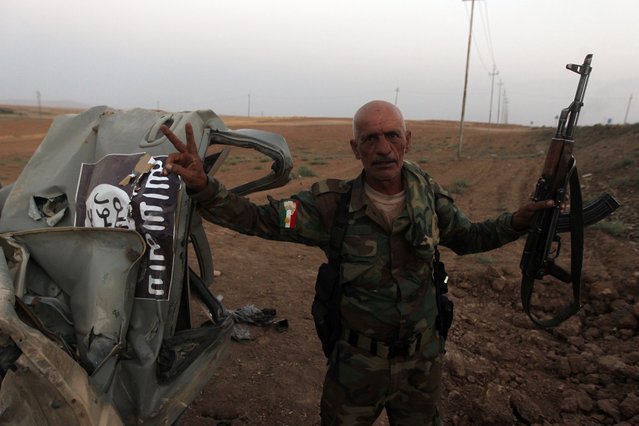
Follow Vox!
Watching the news, you could be forgiven for thinking that ISIS is an unstoppable juggernaut, sweeping Iraq and Syria in an unending, unstoppable, terrible blitzkrieg.
By signing up, you agree to our terms.
But you'd be wrong. The truth is that ISIS's momentum is stalled: in both Iraq and Syria, the group is being beaten back at key points. There are initial signs — uncertain, sketchy, but hopeful — that the group is hurting more than you may think, and has stalled out in the war it was for so long winning. ISIS isn't close to being destroyed. But they are reeling.
ISIS's defeats in Iraq are more important than its gains

(Institute for the Study of War)
In mid-October, ISIS advanced to within 16 miles of the Baghdad
airport. Many observers (and many Iraqis), fearing an ISIS assault on
Baghdad itself, understandably panicked. But to Michael Knights, the
Lafer Fellow at the Washington Institute for Near East Policy, the ISIS
advance meant something else."The threat posed to Baghdad this autumn is emerging less because [ISIS] is winning the war in Iraq," he wrote in Politico Magazine, "and more because it might be slowly but steadily losing it."
To understand what Knights means, you have to understand the basic dynamic of the see-saw war between ISIS and the Iraqi government. The war has been bifurcated: while ISIS has been making big inroads in the western, heavily Sunni Anbar province, it's being pushed back in the other major battlefields around the country, including Rabia, a northwest border town linking ISIS's holdings in Iraq and Syria.
"They appear to have hit their limitations"
In late October, ISIS suffered a defeat in an even more crucial area. Iraqi government forces took Jurf al-Sakhar, a town (in the area labeled Northern Babil in the above map) that Knights describes as an ISIS stronghold. This was a real defeat. As Reuters put it, "the victory could allow Iraqi forces to prevent the Sunni insurgents from edging closer to the capital, sever connections to their strongholds in western Anbar province, and stop them infiltrating the mainly Shi'ite Muslim south."
The question, then, is whether ISIS's recent victories in Anbar have been more important than its defeats. That's not obvious. It's also not obvious that its advances in Anbar can be translated into victories elsewhere; the Anbar campaign owes a lot to the tactical acumen of one commander, the Chechen fighter Abu Umar al-Shishani. "You have Shishani running wild in Anbar, employing very different tactics than ISIS is employing in the rest of Iraq and Syria," says Daveed Gartenstein-Ross, a senior fellow at the Foundation for the Defense of Democracies.
The contrast makes ISIS's setbacks outside of Anbar look even more significant. Shishani doesn't control broader ISIS strategy, nor does he seem capable of turning it around even if he did run it. "In terms of their offensive operations, Anbar is going well," Gartenstein-Ross says. "Everywhere else, they appear to have hit their limitations."
ISIS's siege of Kobane has been a disaster

Kurdish fighters in Kobane. (Ahmet Sik/Getty Images)
In Syria, ISIS isn't facing the same kind of concerted
counter-offensive that it is in Iraq. But it's suffering from a
self-inflicted wound: the stupid, counterproductive siege of Kobane, a Kurdish town in Syria on the border with Turkey.For months, ISIS has been trying and failing to take Kobane. Its recent push, beginning on around September 16, looked likely to succeed. But Kurdish fighters, with heavy American support, have pushed ISIS back. Kobane could still fall, but the Kurdish resistance has shattered the perception of ISIS invincibility — a crucial element of its recruiting pitch.
"The [loss of] prestige in the jihadi movement could do a lot of damage to them," Garteinstein-Ross suggests. "ISIS can draw so many recruits because they're seen as the strong horse, because they're winning. [Kobane] shifts that perception."
Moreover, they've thrown a ton of manpower into Kobane. "They may have lost 4,000 fighters trying to take Kobane," Gartenstein-Ross says. He cautions that the 4,000 number is a spitball estimate; the Syrian Observatory for Human Rights estimates that about 500 ISIS fighters have died since September 16. But there's been fighting over Kobane since August 2013.
The loss of prestige and of personnel compound one another. The more people ISIS loses, the more it needs new fighters. But the defeats make people less likely to volunteer. ISIS has already been conscripting local Syrians and Iraqis to fill its ranks; they may need to conscript even more to make up for the losses, and the involuntary fighters - some of them children - will likely be less effective than voluntary recruits.
Three reasons the war may soon get even worse for ISIS

An airstrike near Kobane. (Kutluhan Cucel/Getty Images)
There are at least three major causes of ISIS's recent defeats. Each
gives us reason to believe that ISIS may only become more vulnerable as
time goes on.First, while American airstrikes are not going to defeat ISIS, they have seriously limited the group's ability to conduct offensive operations. "Airpower has made it difficult for ISIS to concentrate its forces in large numbers," Jason Lyall, a political scientist at Yale University and an expert on counterinsurgency, writes via email. "It has made it more dangerous to reposition its equipment and forces, slowing down its reaction times and complicating its command and control. As a result, ISIS is a far more dispersed force than it was in June."
The harder it is for ISIS to fight in the open, the harder it is for it to put together troop-intensive drives to conquer territory. If ISIS can't expand, it can only preserve what it has or retract.
Second, ISIS's enemies are adapting. ISIS "is a military power mostly because of the weakness and unpreparedness of its enemies," Knights writes in West Point's Sentinel journal. ISIS's advances depend on its ability to launch lightning-quick strikes against opponents that aren't ready for it. Iraqi and Kurdish forces, with American support, are finally learning how to counter these tactics.
"Airpower alone is insufficient to defeat ISIS"
Third, ISIS's so-called caliphate has hamstrung its military options. "When they declared the caliphate, their legitimacy came to rest on the continuing viability of their state," Gartenstein-Ross writes.
If ISIS didn't have to run the caliphate, its smart strategic move would be to melt into the surrounding populations, wait for Iraqi and Syrian troops to enter the area, and then fight them as an insurgency. But the obligations of running a caliphate means that the fighters need to stay visible and out in the open —leaving them exposed and vulnerable.
But don't count ISIS out yet

Kashmiri demonstrators hold up an ISIS flag during a
demonstration against Israeli military operations in Gaza, in downtown
Srinagar on July 18, 2014. (Tauseef Mustafa/AFP/Getty Images)
These setbacks are significant, as is the group's slowing momentum.
But to be clear, none of it specifically points to ISIS getting closer
to collapsing. "On balance, ISIS is probably in a stronger position
today than it was" in mid-July, Lyall writes. ISIS has consolidated
control over its core strongholds, such as Mosul in Iraq and Raqaa in
Syria."It would be a mistake to read too much into these local reversals" in Iraq, Lyall writes. "ISIS has proven adaptive, especially in moving its forces around on the battlefield and in coordinating multi-pronged offensives. A temporary setback in one area may only mean that ISIS is repositioning for a wider effort somewhere else."
Things like US air strikes are good for stalling ISIS's advance, but to be clear, they are not going to defeat the group. "Airpower alone is insufficient to defeat ISIS or even degrade it seriously," Lyall cautions. "Instead, its role is to make ISIS work harder to control and extend its territory while buying time for the Iraqi Army."
So it's best to see the recent ISIS setbacks as evidence that ISIS is vulnerable rather than as a harbinger of any looming collapse. The fact that is being rolled back in some areas indicates that the group can be budged, but the group's total defeat is unlikely, absent a collapse in Sunni civilian support and more effective opposition in Syria.
"I don't think these latest losses are things that ISIS is incapable of recovering from," Gartenstein-Ross says. "There are always ebbs and flows in any war, and I expect there to be [ISIS] gains. But overall, they're a weaker organization than they were at the beginning of August."
Watch: Obama's 2014 evolution on ISIS, in under 3 minutes
Card 9 of 10
Launch cards
Myth #9: ISIS is invincible
Reading the news of
ISIS's conquests in Iraq and Syria, and even its recent foray into
Lebanon, you might get the sense that ISIS is unstoppable. That it'll
sweep Iraq, and really, truly, establish an extremist Islamic state in
Iraq and eastern Syria.
This isn't true. ISIS is smarter and more effective than it used to be, and it's too strong to collapse on its own, but it's still quite vulnerable. The Iraqi government, with Kurdish and American help, really could make major inroads against ISIS.
In June, when ISIS was sweeping Iraq, there were panicked predictions that Baghdad was about to fall to ISIS's advance. It didn't. ISIS didn't even try to take the city, likely because it knew it couldn't dislodge the huge concentrations of Iraqi troops there — or hold a majority-Shia city that would never accept it.
Iraqi demographics place a natural limit on ISIS's advance. Even high-end estimates of ISIS's strength — 50,000 troops — make it much smaller than the Iraqi army or Kurdish peshmerga. It'd be impossible for ISIS to take and hold majority Shia areas, where they'd be totally unable to build popular support. The Islamic State's borders in Iraq are limited to northern and western, Arab-majority, Sunni-majority Iraq.
That's a damning problem for ISIS. All of the major oil wells, which provide 95 percent of Iraq's GDP, are in southern Iraq or Kurdish-held territory in the northeast. ISIS can't advance on the Shia south, and a joint US-Kurdish campaign is reversing its gains in Kurdistan. ISIS has huge financial reserves for a militant group — maybe up to $1 billion dollars. But that's a relatively small amount for a government, and any attempt to actually govern northwestern Iraq in the long run would lead to economic disaster.

When you pair the inevitable economic crisis in ISIS-held Iraq with ISIS's brutal legal system, it seems like Sunnis will eventually tire of the group. That discontent may not be enough on its own to end the group's rule, especially if it still believes the Iraqi central government would be worse for them. But it creates an opening for Iraqi Prime Minister-delegate Haider al-Abadi to reach out to disaffected Sunnis. He might be able to make allies among Sunni tribal militias.
Meanwhile, ISIS may alienate some its core Iraqi allies: militias who support a Saddam-style Sunni dictatorship. They're generally secular and no fans of ISIS's vision of Islamic law, and are only allied with it to fight the government. If ISIS's Sunni allies turn against it, and the government does a better job making its rule look attractive, ISIS may lose the Sunni population — and most of its gains in northern Iraq. Again, that's not inevitable, and will require some tough political changes in Baghdad, but the point is that ISIS is far from invincible.
ISIS's hold in Syria, though, would be much, much harder to dislodge. It's hard to imagine either Assad or moderate anti-Assad rebels mounting an effective military campaign against ISIS in the near term. But rolling back ISIS in Iraq, and containing it to Syria, would be a major victory, though an incomplete one as it would leave ISIS with a chunk of Syria. Still, this would limit the group's reach in the Middle East and blunt its global appeal. And when Syria's civil war finally does end, whenever that happens, eliminating ISIS will be the winning side's first priority.
This isn't true. ISIS is smarter and more effective than it used to be, and it's too strong to collapse on its own, but it's still quite vulnerable. The Iraqi government, with Kurdish and American help, really could make major inroads against ISIS.
In June, when ISIS was sweeping Iraq, there were panicked predictions that Baghdad was about to fall to ISIS's advance. It didn't. ISIS didn't even try to take the city, likely because it knew it couldn't dislodge the huge concentrations of Iraqi troops there — or hold a majority-Shia city that would never accept it.
Iraqi demographics place a natural limit on ISIS's advance. Even high-end estimates of ISIS's strength — 50,000 troops — make it much smaller than the Iraqi army or Kurdish peshmerga. It'd be impossible for ISIS to take and hold majority Shia areas, where they'd be totally unable to build popular support. The Islamic State's borders in Iraq are limited to northern and western, Arab-majority, Sunni-majority Iraq.
That's a damning problem for ISIS. All of the major oil wells, which provide 95 percent of Iraq's GDP, are in southern Iraq or Kurdish-held territory in the northeast. ISIS can't advance on the Shia south, and a joint US-Kurdish campaign is reversing its gains in Kurdistan. ISIS has huge financial reserves for a militant group — maybe up to $1 billion dollars. But that's a relatively small amount for a government, and any attempt to actually govern northwestern Iraq in the long run would lead to economic disaster.

A guard at a Kurdish oil facility. Safin Hamed/AFP/Getty Images
"It'd be a permanent downward economic spiral — like Gaza, basically," Kirk Sowell, a risk analyst and Iraq expert, says. An ISIS mini-state is just not sustainable.When you pair the inevitable economic crisis in ISIS-held Iraq with ISIS's brutal legal system, it seems like Sunnis will eventually tire of the group. That discontent may not be enough on its own to end the group's rule, especially if it still believes the Iraqi central government would be worse for them. But it creates an opening for Iraqi Prime Minister-delegate Haider al-Abadi to reach out to disaffected Sunnis. He might be able to make allies among Sunni tribal militias.
Meanwhile, ISIS may alienate some its core Iraqi allies: militias who support a Saddam-style Sunni dictatorship. They're generally secular and no fans of ISIS's vision of Islamic law, and are only allied with it to fight the government. If ISIS's Sunni allies turn against it, and the government does a better job making its rule look attractive, ISIS may lose the Sunni population — and most of its gains in northern Iraq. Again, that's not inevitable, and will require some tough political changes in Baghdad, but the point is that ISIS is far from invincible.
ISIS's hold in Syria, though, would be much, much harder to dislodge. It's hard to imagine either Assad or moderate anti-Assad rebels mounting an effective military campaign against ISIS in the near term. But rolling back ISIS in Iraq, and containing it to Syria, would be a major victory, though an incomplete one as it would leave ISIS with a chunk of Syria. Still, this would limit the group's reach in the Middle East and blunt its global appeal. And when Syria's civil war finally does end, whenever that happens, eliminating ISIS will be the winning side's first priority.
Where are the world's most dangerous transit systems for women?
By CNN Staff
October 29, 2014 -- Updated 0005 GMT (0805 HKT)
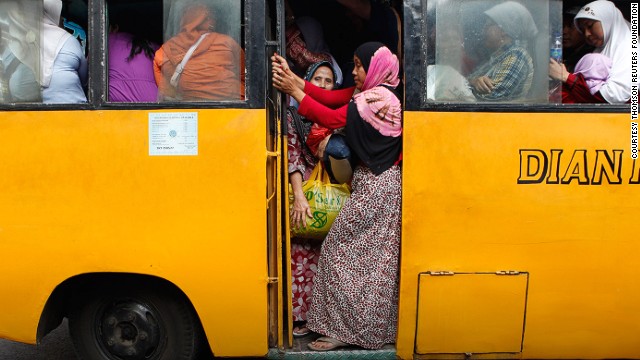 Women surveyed in
Jakarta, Indonesia, were the second-most supportive of implementing
women-only carriages on trains to prevent harassment.
Women surveyed in
Jakarta, Indonesia, were the second-most supportive of implementing
women-only carriages on trains to prevent harassment.
<<
<
1
2
3
4
5
6
7
8
9
10
11
12
13
14
15
16
>
>>
STORY HIGHLIGHTS
- Thomson Reuters Foundation says six in 10 women in major Latin American cities report having been physically harassed while using transport systems
- Bogota, Colombia, found to have the most unsafe public transport, followed by Mexico City and Lima
- New York rated as the best of the 16 cities followed by Tokyo, Beijing and London
According to the new
report, six in 10 women in major Latin American cities report they've
been physically harassed while using transport systems, with Bogota,
Colombia, found to have the most unsafe public transportation, followed
by Mexico City and Lima, Peru.
At the other end of the
safety spectrum, New York was rated as the best of the 16 cities studied
followed by Tokyo, the world's largest capital with 38 million people,
then Beijing and London.
The poll was conducted in
15 of the world's largest capitals, as well as New York, the most
populous city in the United States, in collaboration with UK polling
company YouGov.
Here are the results, from ranked from worst to best:
1. Bogota, Colombia
2. Mexico City
3. Lima, Peru
4. New Delhi
5. Jakarta, Indonesia
6. Buenos Aires
7. Kuala Lumpur, Malaysia
8. Bangkok
9. Moscow
10. Manila, Philippines
11. Paris
12. Seoul
13. London
14. Beijing
15. Tokyo
16. New York
In total, 6,555 women and experts were surveyed.
Results are based on the
respondents' answers as well as surveys of experts in women's rights,
gender equality, urban planning and gender-friendly urban spaces in each
of the cities.
The Thomson Reuters
Foundation said polling could not be conducted in five other large
capitals -- Cairo, Dhaka (Bangladesh), Kinshasa (Democratic Republic of
the Congo), Tehran and Baghad -- due to conflict or an inability by
polling company YouGov to guarantee the necessary online sample of
women.
The group says it did
survey 10 experts in Cairo, the world's fifth largest capital, but those
findings were not included in the overall ranking as YouGov could not
carry out the public poll.
Had they been included,
it would have put Cairo in the top five most dangerous transport
systems, said the Thomson Reuters Foundation.
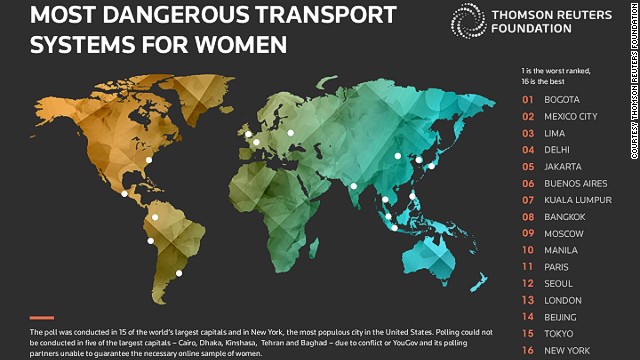 Most dangerous transport systems for women.
Most dangerous transport systems for women.
What constitutes harassment?
The foundation says the
survey was conducted in many different cultures, and allowed respondents
to judge what constituted harassment in their own society.
Women were asked six
questions relating to: how safe they felt traveling alone at night; the
risk of being verbally harassed by men; the risk of being groped or
subjected to other forms of physical harassment; trust that other
passengers would assist a woman being physically or verbally abused; and
trust in authorities to investigate reports of sexual harassment or
violence.
In Moscow, respondents
reportedly had little confidence that authorities would investigate an
abuse report, while 85% of Paris women doubted fellow public transport
users would come to their rescue if they were in trouble.
In an accompanying
Thompson Reuters Foundation report based on the survey, Mary Crass, head
of policy at the International Transport Forum, an OECD think tank,
said it was worrying that women were scared to use public transport in
some major cities and the poll highlighted the need for more action.
"When there is not
frequent, reliable, accessible transport, this can affect women and
anyone's ability to access opportunity and notably employment in urban
areas, which can make a big difference for women in particular," she
said.
"(Women) tend to be more
reliant on public transport and on non-motorized means, particularly in
low-income or middle-income countries, in emerging economies."
Women-only cars a short-term fix, say experts
Tokyo's high standing
may come as a surprise to those familiar with the highly publicized
problems women have faced when riding Japanese subways, with widespread
reports of groping consistently making headlines.
The Thompson Reuters
Foundation said experts attributed Tokyo's second place ranking to a
raft of measures taken in the city over recent years to combat such
incidents in often overcrowded buses and trains.
These include the introduction of women-only trains in 2000, which are color-coded in pink, and transit police to enforce rules.
Women-only sections on public transport are now also found in Jakarta, Kuala Lumpur, Delhi, Cairo and Manila.
Thomson Reuters
Foundation said other cities, including London, are considering this
option and introducing CCTV on platforms and improving lighting.
However, gender and city planning experts have raised concerns over whether women-only transport is effective.
Julie Babinard, senior
transport specialist from the World Bank, says they're a short term fix
and not a panacea for harassment of women.
"The emerging interest
in several countries on women-only initiatives should be seen as an
opportunity for improving security in cities but not as a silver bullet
for dealing with gender-based violence in transportation and urban
settings," Babinard told the Thomson Reuters Foundation.
"Women-only initiatives
are not likely to provide long-term solutions as they only segregate by
gender and provide a short-term remedy instead of addressing more
fundamental issues."
Although experts remain critical of single-sex transport, most women favored the idea, according to the survey.
.............................................
Poor treatment of women points to India's widening gender gap
By Ravi Agrawal, CNN
October 28, 2014 -- Updated 0830 GMT (1630 HKT)
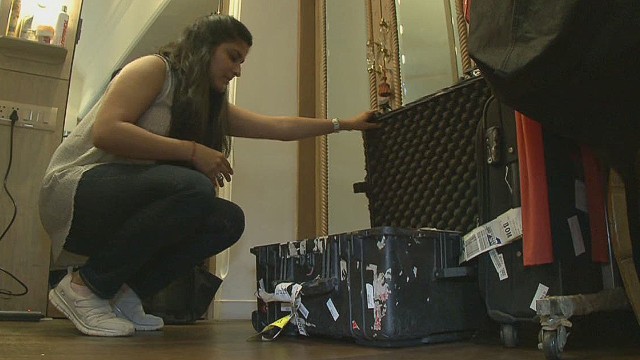
Bollywood: Women do hair, men do make-up
STORY HIGHLIGHTS
- World Economic Forum's new Gender Gap Index gives India a dismal scorecard
- 134th out of 142 in the world for economic opportunities; 126th for educational attainment
- Women are born at a disadvantage, enjoying far few opportunities than men
- Gender gap may help to explain poor treatment of women, including issues such as security, rape
Editor's note: Ravi Agrawal is CNN's New Delhi Bureau chief. Follow him on Twitter @RaviAgrawalCNN. The opinions expressed in this commentary are solely those of the author.
New Delhi (CNN) -- Every five minutes a woman in
India is compelled to visit a police station and report a case of
cruelty -- usually one committed by her own husband or family.
Every ten minutes a woman in India reports assault. Every 21 minutes one of them reports a rape.
The numbers are no secret: you can do the math from the National Crime Records Bureau yourself.
The total number of these
assorted cases has increased in each of the last five documented years,
making for a 25% jump over this period.
But the numbers don't
tell the complete truth. At the very least, they are frequently
misrepresented. With each high profile rape in India -- sensationally
reported in national and sometimes international media -- the increased
number of reported crimes is cited as an example of how the incidence
rape in India is on a steep upward curve.
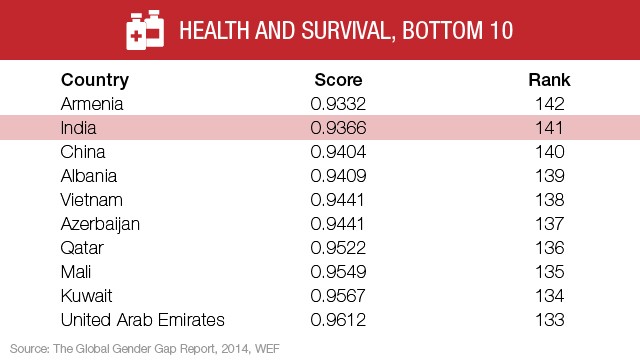 Health: Top 10 nations
Health: Top 10 nations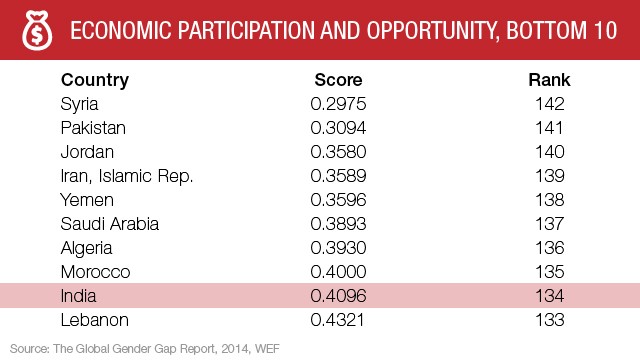 Economic participation: Top 10 nations
Economic participation: Top 10 nations
But it's a lazy
correlation. In reality, we don't really know that the number of cases
of rape are on the rise. All we know is that more women are reporting
these crimes -- perhaps, in part, because of the spotlight on them.
Either way, the number of women not reporting rapes and other crimes is a
far bigger statistic -- many are undocumented, brushed under the
carpet, forgotten.
The crimes, as always,
begin at home. It should be no surprise to read about the physical
crimes reported and recorded by the National Crime Records Bureau.
Gender gap
How do we explain why
India has so many cases? There are likely a number of complex
sociological factors but there's not much hard data. One useful
indicator of the safety of Indian women is to look at how they compare
globally on freedom. The World Economic Forum's new Gender Gap Index gives India a dismal scorecard -- worse than in previous years.
India's women rank 134th
in the world (out of 142 countries) for economic opportunities; they
place 126th in the world for educational attainment; 141st in the world
for health and survival. These are all basic rights that would empower
them, make them less likely to be silent victims.
Demographic, economic indicators
-- GDP (US$ billions): 1,458.74
-- GDP (PPP) per capita (constant 2011, international $): 5,050
-- Total population (millions): 1,252.14
-- Population growth (%): 1.24
-- Overall population sex ratio (male/female): 1.07
(Source: WEF)
-- GDP (US$ billions): 1,458.74
-- GDP (PPP) per capita (constant 2011, international $): 5,050
-- Total population (millions): 1,252.14
-- Population growth (%): 1.24
-- Overall population sex ratio (male/female): 1.07
(Source: WEF)
The only parameter India
performs well on is on having a female head of state or government,
where it ranks a surprising first. But the parameter itself is flawed.
In 15 of the 21 years the study counts, Indira Gandhi was prime
minister.
History will hardly portray Gandhi's achievements
as solely a triumph for Indian women; her victory and the length of her
rule was also a triumph of her lineage (Gandhi's father was Jawaharlal
Nehru, India's first prime minister. She shared no relation to the
legendary Mahatma Gandhi, but her surname -- acquired through marriage
-- didn't hurt.)
A more reliable
indicator of the political empowerment of India's women is how it places
111th in the world for electing female parliamentarians, and 107th in
the world for voting in female ministers.
Born at a disadvantage
Why the sorry state of India's women? Why are they so far behind?
The sad reality is that it begins before women are even born. According to India's census,
there are 940 women for every 1,000 men. In part, the difference exists
because of decades of female infanticide -- the practice where families
abort fetuses on discovering their sex. When girls are born, they're
born with the promise of a second class life. While men enjoy a literacy
rate of 82%, only 65% of Indian women can read or write. Girls in India
have long been considered a burden, a cause for losing money in
marriages and dowries.
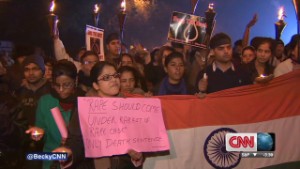 Do women feel safe in India?
Do women feel safe in India?
 India's missing women
India's missing women
Data and anecdotes alike
show that Indian women have been unwanted and unloved for decades.
Consider how families pressure their daughters-in-law for baby boys, not
girls.
Consider how in rural
India, many Indian parents mistreat their daughters-in-law, demanding
dowries, mothers-in-law meting out the same discrimination they were
once subjected to. An overwhelming 43% of crimes reported by Indian
women are acts of cruelty committed by their own families. Millions of
Indians -- men and women -- are complicit.
The discrimination
continues at a policy level: marital rape is still not considered a
crime in India. Local governments and police remain poorly equipped to
process crimes against women -- let alone doing so in a sensitive
manner.
So why are many shocked by India's abysmal statistics on crimes against women?
The crimes, as always,
begin at home. It should be no surprise to read about the physical
crimes reported and recorded by the National Crime Records Bureau. What
is surprising is how generations of Indians have stood by as their
mothers, sisters, and daughters have been left behind on every indicator
of quality of life; they have been denied the chance for basic
equality.
The WEF report makes for
illuminating reading, and signposts where India needs to go to fully
realize the potential of its 600 million female inhabitants.
วันจันทร์ที่ 27 ตุลาคม พ.ศ. 2557
Meet the former egg seller who made millions by shining shoes
By Alex Court, for CNN
October 27, 2014 -- Updated 1045 GMT (1845 HKT)
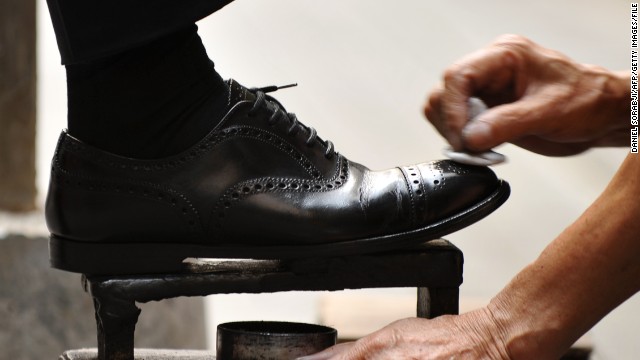 When he started
shining shoes, Mgayiya had no experience. He often slipped and got
polish on his customers' socks which upset people.
When he started
shining shoes, Mgayiya had no experience. He often slipped and got
polish on his customers' socks which upset people.
HIDE CAPTION
Investing winnings
<<
<
1
2
3
4
5
>
>>
STORY HIGHLIGHTS
- Lere Mgayiya spent five years working for South Africa Airways
- He worked with livestock on his family's business
- Winning the Sandlam Money Game on TV led to a quick cash injection
- Now, his shoeshining business has 45 staff and turnover of more than 2.5 million rand
Every week, African Start-Up
follows entrepreneurs in various countries across the continent to see
how they are working to make their business dreams become reality.
(CNN) -- Suede slip-ons, elegant high-heels or
lace-up brogues -- whatever shoes you wear in an important business
meeting you want to look your shiny best. Some people apply polish with a
brush and others choose a cloth, while those coming from afar often
leave the task to the capable hands of craftsmen who can make
travel-worn footwear look like brand new.
If someone has shined your shoes in a South African airport, it's probably thanks to Lere Mgayiya.
"We're the biggest
shoe-shine company in Africa," he explains without sounding arrogant.
"In Johannesburg we shine about 350 pairs of shoes a day, and about 120
pairs in Cape Town and another 120 in Durban." In total, Lere's Shoe
Shine business has 45 employees across the three major airports, and the
boss is now eyeing partnerships in America and UK, as well as expansion
across Africa.
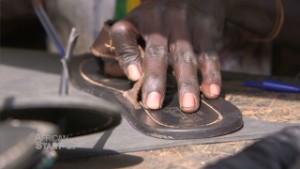 Shoe making saves street kids
Shoe making saves street kids
 'Inspired learning' transforms education
'Inspired learning' transforms education
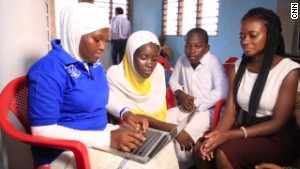 Breaking down barriers for women in tech
Breaking down barriers for women in tech
On this particularly day,
Mgayiya, 40, is wearing Clarks -- black slip-ons. With annual revenue
nearing 2.5 million rand ($227,000), his demeanor resembles his feet --
comfortable.
But things weren't always
on such a sure footing for Mgayiya. The resourceful South African had
to go through a string of failures to get to where he is today -- a
spectacular entrepreneurial journey of risk, belief and reward.
Airborne beginnings
Long before becoming
South Africa's shoe shining king, Mgayiya started his professional
career distributing boarding cards for South African Airways. But after
five years with the airline and a promotion to supervisor, Mgayiya was
made redundant. "I wasn't ready to leave," he recalls. "If the truth be
told, I was afraid -- it gave me a push."
Mgayiya stopped handling
paper and joined the family livestock transportation business. "I
enjoyed being out and about," he says, while explaining his role
negotiating with farmers. "I enjoyed setting my own goals and achieving
them."
But life in a family
business wasn't all plain-sailing. When Mgayiya suggested taking a loan
and securing exclusive contracts, his uncle asked him to move on. After a
year, he was jobless again.
Failed attempts
His mother's brother
took away his job, but Mgayiya kept in contact with his farmer clients
and soon embarked on his next project: selling the farmers' eggs to the
kitchen of the South African parliament. Making just $6 profit per egg
box, this however was not a lucrative operation. "I fell behind with
payments to farmers," he remembers. "I didn't have money to start my
car. You need big pockets to run a supply business."
When his chips were
down, Mgayiya stayed optimistic and entered the Sandlam Money Game -- a
TV competition for entrepreneurs. Marketing execs at Red Bull liked his
advertising idea, and Mgayiya won the game. "I got 35,000 Rand ($3,100)
in two days," he says. "It was great."
A hungry man can't think, and I was starving.
Lere Mgayiya, Lere's Shoe Shine
Lere Mgayiya, Lere's Shoe Shine
He took that money and
invested it all in a tree-planting company which he then started working
for. But six months later things went sour, and Mgayiya was penniless
again and back at square one.
Mgayiya had already
experienced hard times, but the year to come was to test his resolve. "I
needed a steady income, so I decided on a shoe-shining business at Cape
Town airport. A hungry man can't think, and I was starving."
He got in touch with his
contacts from his airline days and applied for the business space in
November 2002. The authorities took until September 2003 to give him the
go ahead. "In that year I sold my car...I worked as a receptionist for
three months. I begged and borrowed just to make ends meet."
Business beginnings
Before he could start
shining shoes, Mgayiya pawned his fridge to buy business equipment. But
on his first day Mgayiya and his sole employee arrived to bad news. "The
supplier I had paid to provide pedestals failed to deliver," Mgayiya
remembers. "I polished shoes in my lap."
When starting a business in South Africa, you need self-belief.
Lere Mgayiya, Lere's Shoe Shine
Lere Mgayiya, Lere's Shoe Shine
In the beginning, both
staff members worked flat out 5am to 9pm every day of the week except
Sunday. "I left the house before my family woke up, and only got home
after my young daughter had gone to sleep," he recalls. "It was tough."
But customer numbers
soon got a boost after a client suggested that the business name should
highlight the personal, chatty aspect of the business. "Airport
Shoeshine" became "Lere's Shoe Shine," and people liked it -- after just
four months. the team had grown to five and business was booming.
Big plans
Success in Cape Town
didn't cool Mgayiya's ambition, and after a year he got a chance to
pitch to the person in charge of all South African airports. She liked
his idea, and expansion started soon after. At its height, the company
had 60 employees in five airports across the country. Today, Mgayiya has
scaled back to the three major ones: Cape Town, Durban and
Johannesburg.
"I have my own house and
send my daughter to private school," he beams. "And I could afford to
get married -- a proper marriage." He no longer works from 5am to 9pm
either. "I just do the one shift from 12," he says, laughing. "The
family loved that one."
"When starting a
business in South Africa, you need self-belief," is his top advice for
young entrepreneurs. "All the conditions will never all be favorable at
the same time. If you don't start, you won't go anywhere -- you have to
start."
While he's under way
now, Mgayiya shows no signs of stopping. He has his eyes on Angola,
Kenya and Nigeria for expansion, as well as partnerships in U.K. and
America. His shine for business may have emerged from a number of
failures, but this entrepreneur shows how smudges and setbacks shouldn't
get in the way of success.
Prison camp escapee: North Korea won't change its repressive ways
By Shin Dong-hyuk, Special to CNN
October 28, 2014 -- Updated 0357 GMT (1157 HKT)
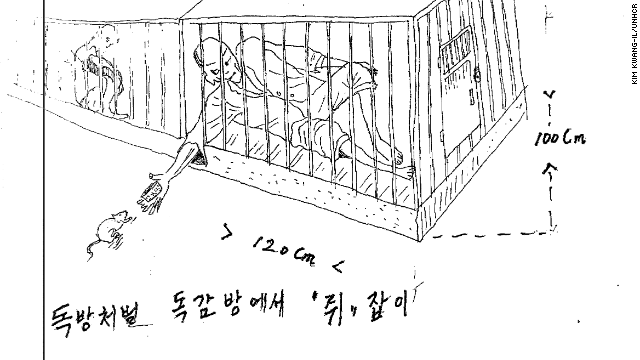 Text: "Solitary confinement punishment. Capturing mice from inside the cell."
Text: "Solitary confinement punishment. Capturing mice from inside the cell."
HIDE CAPTION
North Korean torture methods
<<
<
1
2
3
4
5
6
7
8
>
>>
STORY HIGHLIGHTS
- Shin Dong-hyuk was raised in a political prison known as Camp 14
- He has been labeled as "human scum" by North Korea
- North Korea denies human rights atrocities, existence of political prison camps where he was born
Editor's note: Shin
Dong-hyuk is a human rights advocate and subject of the best-seller
"Escape From Camp 14," which tells his story about being born and raised
in a brutal political prison camp in North Korea. Shin is the only man
known to have been born in and to have escaped such a facility. He's the
founder and executive director of the group, Inside NK where he raises
awareness about North Korea's human rights abuses. The opinions
expressed in this commentary are solely those of the writer.
(CNN) -- In North Korea's utopian society, the very
words "human rights" do not need to exist -- because it's so perfect,
the regime maintains.
The North Korean regime
controls and monitors the usage of the very words. The concept is not
even taught. I had never even heard of the term "human rights" when I
was in North Korea.

Shin Dong-hyuk is the subject of a bestseller about escaping from North Korea's infamous prison camp.
It also strongly denies the existence of the political prison camp system throughout the country.
It maintains this
position even though I was born in the most infamous, political prison
camp in North Korea: Camp 14. Even now, there are people who are born
into a life of an inmate in a political prison camp.
North Korea also denies
committing human rights violations, threatens and intimidates defector
activists working to raise awareness of human rights issues, and
attacking and criticizing those who have testified during the United
Nations Commission of Inquiry's investigation, calling these defectors
"human scum."
 Looking back at life in a prison camp
Looking back at life in a prison camp
 UN hears story of North Korean torture
UN hears story of North Korean torture
 Understanding North Korea
Understanding North Korea
North Korea has also
launched personal attacks on me, labeling me "human scum" and releasing a
statement that my testimony is all based on lies.
The dictatorship in North Korea has never been honest or truthful for more than six decades it has been in existence.
Could North Korea change?
The North Korean
dictatorial regime should not just emptily deny that these political
prison camps exist. If they are truly honorable and fair they should
immediately allow an international inspection delegation, comprised of
myself and organizations such as Amnesty International or Human Rights
Watch, or the United Nations, to be able to conduct on-the-ground
visitations to the political prison camps. These delegations must
include political prison survivors like myself and other defectors.
Only recently did they
concede that "labor detention centers" exist, but solely for the
incarcerated to have their lives improved "through their mentality and
to look on their wrongdoings."
Earlier this year, the UN published a report on the human rights situation in North Korea, through the Commission of Inquiry that was established last year.
It was followed by a
special North Korean human rights side event during the recent UN
General Assembly in New York in which U.S. Secretary of State John
Kerry, the newly appointed UN High Commissioner for Human Rights Zeid
Ra'ad Al Hussein, and the Foreign Ministers of Japan and South Korea
demanded improvements in North Korea's human rights record.
To counter this, and
perhaps fearing a challenge to its stability and of losing the
initiative, the regime adamantly opposed and obstructed any discussions
at the UN of a resolution regarding its rights record, as well as the
issue being brought up at the Security Council.
 North Korea: UN report a political plot
North Korea: UN report a political plot
I believe ultimately the
regime is using diplomatic tactics to deflect pressures from the
international community regarding its nuclear ambitions, missile tests
and human rights violations.
 Amnesty: Victims need to come forward
Amnesty: Victims need to come forward
 North Korea's human rights treatment
North Korea's human rights treatment
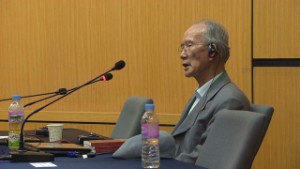 North Korea defectors speak at UN inquiry
North Korea defectors speak at UN inquiry
Regime travels freely as North Koreans starve
Some say that the most
recent actions and conciliatory gestures on the part of the North Korean
regime can lead to the revival of six-party talks and progress on the
nuclear issue. But these talks have happened many times before, and the
regime still goes ahead and conducts nuclear tests in a bid to become a
nuclear power. This has showed the abject failure of the objectives of
the six-party talks to denuclearize the peninsula.
Even if negotiations
were to be restarted, the attitude of the regime must change first --
most importantly by ceasing its provocative behavior.
However, though there
may be a temporary détente in tensions if the regime were to participate
in restarted talks, it would be difficult to expect a fundamental
change in attitude on the part of the North Korean regime.
Also, the human rights
issue must be on the same level as the nuclear issue and dealt with
together, and for this to happen, the human rights issue must be
included as an integral part of six-party talks.
The international community must show continued interest and become actively involved.
The dictator's family
travel freely, while ordinary North Koreans cannot enjoy any freedom of
travel. People are dying of hunger while the North Korean dictator
wastes money on building a useless golf course and earns money from
Western tourism, which both angers and saddens me.
The dictatorship in Pyongyang says its citizens chose the system in North Korea through their own will and that they are happy.
But there is no place,
no country on this Earth where the people would knowingly choose a
system that starves and kills its own citizens and be happy.
Footnote:
The North Korean
government website Uriminzokkiri released videos about Shin Dong-hyuk
this week, calling his testimonies lies. The video featured a man, Sin
Kyong Sop, whom Shin recognized to be his father. In the video, which
has English subtitles, Sin denies they lived at a prison camp.
In response, Shin Dong-hyuk released this statement:
"My only 'sin' against
the North Korean dictator is that I told the entire world about the
suffering of the political prison inmates in the political prison camps.
My only 'crime' against the dictator is that I escaped from the
political prison camp.
I love my father. Through this, I seek my father's forgiveness. The dictator is holding my father hostage.
No matter what the
dictator does to my father, they cannot cover my eyes; no matter what
the dictator does, they can not cover up my mouth."
วันศุกร์ที่ 24 ตุลาคม พ.ศ. 2557
พระสมเด็จแตกลายงา
โดยทั่วไปพระสมเด็จแตกลายงามักจะหาหรือพบเห็นได้ยาก เป็นพระพิมพ์ใหญ่ส่วนมากและการแตกลายงาจะเป็นเฉพาะด้านหน้า ทั้งนี้อาจจะเป็นเพราะว่าการวางหรือเก็บรักษาพระที่ด้านหน้าอาจจะสัมผัสกับแสงแดดมากและอาจจะเป็นระยะเวลานานไปตลอดช่วงที่ยังมีความชื้นของพระอยู่
พระสมเด็จองค์ที่ลงให้ชมนับว่ามีสภาพการแตกลายงาที่สวยมากๆ สภาพพระแห้งสนิท มีความเป็นธรรมชาติของการเก่าเก็บ มีมวลสาร และพิมพ์ทรงการตัดกรอบที่ดี พระไม่แตกหัก เคาะมีเสียงดังกังวาลแสดงให้เห็นว่าภายในแห้งสนิทสุดๆสมกับผ่านระยะเวลามากว่าร้อยปี
ภาพถ่ายใกล้เคียงของจริงเกือบร้อยเปอร์เซ็นต์
ถือว่าเป็นพระสมบูรณ์แบบจริงๆ
ม.โชคชัย ทรงเสี่ยงไชย
พระสมเด็จองค์ที่ลงให้ชมนับว่ามีสภาพการแตกลายงาที่สวยมากๆ สภาพพระแห้งสนิท มีความเป็นธรรมชาติของการเก่าเก็บ มีมวลสาร และพิมพ์ทรงการตัดกรอบที่ดี พระไม่แตกหัก เคาะมีเสียงดังกังวาลแสดงให้เห็นว่าภายในแห้งสนิทสุดๆสมกับผ่านระยะเวลามากว่าร้อยปี
ภาพถ่ายใกล้เคียงของจริงเกือบร้อยเปอร์เซ็นต์
ถือว่าเป็นพระสมบูรณ์แบบจริงๆ
ม.โชคชัย ทรงเสี่ยงไชย
วันพุธที่ 1 ตุลาคม พ.ศ. 2557
Global AgeWatch Index: Norway best for older people
Norway is the best place to grow old, according to an index of the quality of later life in 96 countries.
HelpAge International's Global AgeWatch Index measures the social and economic welfare of those over 60.
Published on the UN International Day of Older Persons, it ranks Australia, Western Europe and North America highly, and Afghanistan last.
The report predicts that by 2050, 21% of the global population will be over 60.
The index measures four areas - income security, health, personal capability and whether the person lives in an "enabling environment".
Hot on the heels of Norway comes Sweden, closely followed by Switzerland, Canada and Germany.
The report says that by 2050, some 40 countries in the index will have populations where 30% are aged 60 or over.
The UN has said that the number of those aged 60 or over is expected to reach 1.4 billion by 2030.
Experts point out that the increasing numbers of people surviving into older age are, of course, a cause for celebration - advances in healthcare and in nutrition, better sanitation, and more economic prosperity are all contributory factors.
Add in other factors like falling birth rates and it is clear why we see not just more people living longer, but countries with higher percentages of older people as well.
But the question is whether this can be turned into more positive ageing for those who have little or no social protection or savings - an acute challenge for many in the developing world.
It is made worse where the tradition of caring for the elderly within extended families is weakening.
There is change taking place. The growth of tax-financed, non-contributory "social pensions" is seen as key to helping to tackle inequality for the older age group.
A slogan often heard in global development is "leave no-one behind" - the welfare of those in later life is as much of a test of it as the young.
Grey line
Several Latin American countries - particularly Mexico and Peru - have leapt up the index for their commitment in ensuring "social pensions" for the poorest older people.
These are tax-financed, non-contributory pensions that ensure a basic income for the most vulnerable.
In Mexico, nearly nine out of every 10 people aged 65 and over receive a social pension.
Because of this, Mexico ranks at 30 on the index, outstripping the BRICS nations - Brazil, Russia, India, China and South Africa.
Peru has implemented the Pension 65 programme, which provides older people with 250 nuevo soles (£53) every two months.
Your comments (203)
สมัครสมาชิก:
บทความ (Atom)

